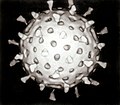Viroplasm

A viroplasm, sometimes called "virus factory" or "virus inclusion",
Definition
A viroplasm is a perinuclear or a cytoplasmic large compartment where viral replication and assembly occurs.[2] The viroplasm formation is caused by the interactions between the virus and the infected cell, where viral products and cell elements are confined.[2]
Groups of viruses that form viroplasms
Viroplasms have been reported in many unrelated groups of
| Baltimore's classification | Family | Species |
| I: dsDNA viruses | Poxviridae Asfarviridae Iridoviridae Mimiviridae |
vaccinia virus[7]
African swine fever virus[8]
Herpes simplex virus[2]
|
| II: ssDNA viruses | ||
| III: dsRNA viruses | Reoviridae
|
Avian reovirus[11]
|
| IV: (+)ssRNA viruses | Togaviridae
Flaviviridae |
Rubella virus[12] |
| V: (−)ssRNA viruses | Rhabdoviridae | Rabies virus[13] |
VI: ssRNA-RT viruses
|
Retroviridae
|
Human immunodeficiency virus[15]
|
VII: dsDNA-RT viruses
|
Caulimoviridae | Cauliflower mosaic virus[16] |
Structure and formation
Viroplasms are localized in the perinuclear area or in the cytoplasm of infected cells and are formed early in the infection cycle.[2][17] The number and the size of viroplasms depend on the virus, the virus isolate, hosts species, and the stage of the infection.[18] For example, viroplasms of mimivirus have a similar size to the nucleus of its host, the amoeba Acanthamoeba polyphaga.[9]
A virus can induce changes in composition and organization of host cell cytoskeletal and membrane compartments, depending on the step of the viral replication cycle.[1] This process involves a number of complex interactions and signaling events between viral and host cell factors.
Viroplasms are formed early during the infection; in many cases, the cellular rearrangements caused during virus infection lead to the construction of sophisticated inclusions —viroplasms— in the cell where the factory will be assembled. The viroplasm is where components such as
In animal cells, virus particles are gathered by the microtubule-dependent aggregation of toxic or misfolded protein near the microtubule organizing center (MTOC), so the viroplasms of animal viruses are generally localized near the MTOC.[2][19] MTOCs are not found in plant cells. Plant viruses induce the rearrangement of membranes structures to form the viroplasm. This is mostly shown for plant RNA viruses.[17]
Functions
Viroplasm is the location within the infected cell where viral replication and assembly take place.[2] Wrapping the viroplasm with a membrane, concentrates the viral components required for the genome replication and the morphogenesis of new virus particles, so it increases the efficiency of the processes.[2] The recruitment of cellular membranes and cytoskeleton to generate virus replication sites can also benefit viruses in other ways. Disruption of cellular membranes can, for example, slow the transport of immunomodulatory proteins to the surface of infected cells and protect against innate and acquired immune responses, and rearrangements to cytoskeleton can facilitate virus release.[1] The viroplasm could also prevent virus degradation by proteases and nucleases.[17]
In the case of the
Possible co-evolution with the host
Aggregated structures may protect viral functional complexes from the cellular degradation systems. For example, formation of viral factories of the ASFV viroplasm is very similar to the aggresome formation.
Use in diagnostics
Presence of viroplasms is used to diagnose certain viral infections. Understanding the phenomena of virus aggregation and of the cell response to the presence of virus, and whether viroplasms facilitate or inhibit viral replication, may help to develop new therapeutic approaches against virus infections in animal and plant cells.[17]
See also
References
- ^ PMID 17765705.
- ^ PMID 15656780.
- PMID 16453427.
- PMID 9514960.
- PMID 11390577.
- S2CID 22657012.
- PMID 8486734.
- PMID 23059353.
- ^ PMID 17389919.

- PMID 26391910.

- PMID 15276829.
- PMID 20655079.
- PMID 19494013.
- PMID 31470541.
- PMID 8523563.
- ^ a b c d Bak A., Gargani D., Macia J-L., Malouvet E., Vernerey M_S., Blanc S. and Drucker, M. Virus factories of Cauliflower mosaic virus are virion reservoirs that engage actively in vector-transmission. 2013 journal of Virology
- ^ PMID 23202461.
- PMID 18631647.
- S2CID 26616991.
- PMID 11121744.

